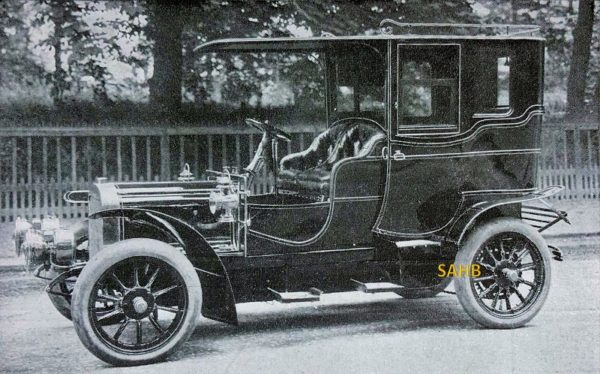
This most English of names disguised the true German origins of the Beaufort, a make that lasted only five years from 1901 to 1906. The company was set up with English capital to manufacture cars specifically for the British market. A significant person behind the venture was Oliver Stanton, who had taught the Prince of Wales (later King Edward VII) to ride a bicycle and drive a car.
At least some of the cars were made by Argus in Germany. The British headquarters of the company were at 14 Baker Street in London, and some reports suggest that cars were assembled there from German-made parts, or perhaps simply bodied in London.
The first Beaufort cars were powered by single-cylinder Bergmann engines and had belt drive, but by 1902 shaft drive was used for the smaller models. The Beaufort entry in Peach’s Motor Annual for 1905 lists a 9-10 h.p. single cylinder, 10-12 h.p. twin, and two four-cylinder models: 16-20 h.p. and 24-30 h.p. The 10-12 h.p. was shaft drive, but the 16-20 h.p. was chain driven, as can be seen in our Snapshot. Both the 10-12 and the 16-20 were advertised as being fitted with mechanical overhead inlet valves, pressed-steel frames and three-speed and reverse gearboxes. There were ‘ball bearings throughout’.
Various bodies were available, those illustrated in Peach’s being a tonneau, a larger phaeton, and the car in our picture: a limousine brougham with the delightfully named “Luggage Grill.” (No suitcases were cooked; this was the spelling used.)
The only Beaufort known to have survived is a 1902 single-cylinder with Renault-style coal-scuttle bonnet and low-slung gilled-tube radiator. It was driven on the 1976 London-Brighton Run by Bill Boddy and the successful journey was written up by him in the December 1976 issue of Motor Sport.
We discovered very little other history about this rare make – except that a Beaufort car was the first motor vehicle to climb Copenhagen’s ‘Round Tower’ landmark in 1902. Such a strange fact naturally led us to find out more, and all became clear: the tower was built in the 17th century as an astronomical observatory. It has a helical ramp leading to the observation platform 34.8 metres above the ground, instead of a staircase. Just the sort of thing to attract an intrepid early motorist to climb it.
Picture courtesy of the Richard Roberts Archive







Beaufort is one of these makes, which seem difficult to grasp. However, after looking again at these 1905 Beaufort models I suddenly realised, that these cars were simply badge-engineered SAF-Gaggenau cars as these are similar in appearance. In 1904 the car department of Bergmann was taken over by Georg Wiβ, who hired Willy Seck as designer, formerly employed by Scheibler. The first car was the small Liliput, already with a more or less similarly shaped radiator. Also a new line of 4 cylinder cars was designed, which were sold as SAF(-Gaggenau) in Germany, but apparently again as Beaufort in the UK.
Theodor Bergmann was already known in the UK from the early days with his Orient-Express, and this was continued with the Bergmann-designed Beaufort and later the Willy Seck-designed models.
Just for the record, Theodor Bergmann has no relation with the Bergmann-Métallurgique, which was founded by the Bergmann Elektrizitätswerken in Berlin.